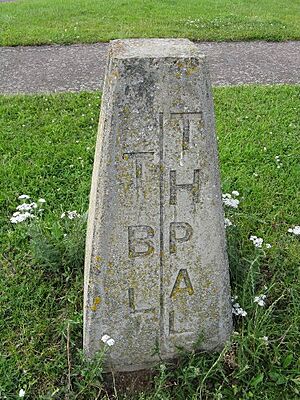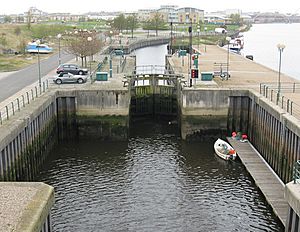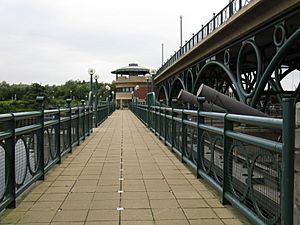Tees Barrage facts for kids
Quick facts for kids Tees Barrage |
|
|---|---|

View of the Tees barrage, bridge and footbridge from the upstream north bank
|
|
| Coordinates | 54°33′51.84″N 1°17′10.32″W / 54.5644000°N 1.2862000°W |
| Carries | Tees Barrage Way – pedestrians and cyclists use the footbridge (Teesdale Way) |
| Crosses | River Tees and Teesdale Way |
| Locale | Stockton-on-Tees, England, United Kingdom |
| Official name | Tees Barrage |
| Maintained by | Canal & River Trust |
| Website | [https://www.teesbarrage.co.uk/about.php |
| Preceded by | Infinity Bridge |
| Followed by | Tees Viaduct |
| Characteristics | |
| Design | arched viaduct |
| Material | concrete, welded tubular steel and plate steel |
| Total length | 160 m |
| Longest span | 7.5 m |
| Number of spans | 8 |
| Piers in water | 3 |
| Load limit | 45 units of HB loading |
| Clearance below | 5 m (5.37 m in the lock) |
| Design life | 120 years |
| History | |
| Designer | Ove Arup and The Napper Partnership |
| Constructed by | Tarmac Construction |
| Fabrication by | Westbury Tubular Structures |
| Construction begin | 4 November 1991 |
| Construction end | 1995 |
| Opened | 22 April 1995 |
| Inaugurated | 17 July 1995 |
| Statistics | |
| Daily traffic | very light |
The Tees Barrage is a special dam built across the River Tees in Stockton-on-Tees, in the North East of England. It helps control the river's flow, stopping flooding and the effects of the tides.
The Tees Barrage includes a river barrier, a road bridge, a footbridge, a special lock for boats, a fish pass for fish, and a white water course.
The water level above the barrage is always kept at the same height as an average high tide. This makes it perfect for fun watersports like canoeing, jet skiing, dragonboat racing, and even has a 1 km rowing course. You can reach the barrage by road mainly from Thornaby-on-Tees.
The Tees Barrage and the Tees Barrage International White Water Course were built by the Teesside Development Corporation.
Contents
How the Barrage Works
The Tees Barrage is a very strong structure designed to last a long time.
Barrage Design
The main concrete base of the barrage is 70 m wide, 32 m long, and 5 m thick. It stands on five strong concrete supports. Between these supports are four huge "fish belly plates." These plates are 8 m tall and weigh 50 tonnes each! They are moved by powerful hydraulic rams (like giant push-pull machines) that weigh 21 tonnes. These plates control how much water flows through the barrage.
Road Bridge Design
The road bridge on top of the barrage weighs 600 tons. It's designed like an arched bridge made of strong steel tubes. It has eight arches, each 17.5 m wide. Only the four middle arches actually cross the river. The arches are painted green to protect them from rust. Building the barrage used a lot of materials: 16,500 cubic metres of reinforced concrete and 650 tons of steel.
Tower of Lights
On one side of the middle support, there's a 29 m tall tower with reflective globes and plates. It's lit up by four lights from the base, which makes it easy to look after.
Barrage Buildings
The barrage has two small buildings called pavilions. One is on the south side, and the other is on the north side, though it's not used much. The south pavilion has the control room for the barrage and offices. There are plans to build a visitors' centre there too. The whole barrage is designed to last for 120 years! The project also helped clean up 100 hectares of nearby land, creating nice riverside walks, parks, and places for fun activities.
Building the Barrage
The idea for the Tees Barrage came from the Teesside Development Corporation. They held a competition to design the bridge, and the winners were Ove Arup and the Napper Partnership. The company Tarmac Construction built the barrage, starting on November 4, 1991.
Tarmac built the barrage by changing the path of the River Tees around the construction site. This meant they could build the barrage on dry land, which was easier and faster than building it in the river.
How the Barrage is Used
The Tees Barrage officially opened on April 22, 1995, with an international competition on the white water course. The Duke of Edinburgh officially opened it on July 17 that same year.
In 2001, the ownership of the Tees Barrage and white water course was given to British Waterways, which is now called the Canal & River Trust. They also look after 11 miles of the River Tees above the barrage, all the way up to Low Moor Weir. The Tees and Hartlepool Port Authority manages the river below the barrage.
Sometimes, lots of natural things like branches get washed down the river and caught by the barrage. Normally, these would go out to sea. People are studying if this debris could be burned to make electricity in special power stations.
Barge Lock
The lock is like a special water elevator for boats. It has two sets of gates that let small boats pass through the barrage. The lock is 24.88 m long, 6.08 m wide, and 5.37 m high, with a depth of 2.48 m.
When a boat needs to pass, a steel lifting bridge over the lock goes up. It's free to use the lock, but boat users need special permits for the river both above and below the barrage.
Testing Tidal Turbines
On June 8, 2007, a new place was opened to test new types of turbines that can make energy from ocean currents. This place is run by the National Renewable Energy Centre. It uses the water in the barge lock to create a controlled flow, like a steady ocean current, to test these turbines.
The first turbine tested here was called Evopod, which is a floating tidal turbine. The test was very successful! Other devices are also planned to be tested here.
Tees Barrage International White Water Course
As part of the barrage project, an artificial whitewater course was built. This amazing £4.6 million facility opened before the 2012 London Olympics. It has hosted many important watersport competitions. The course even makes its own green energy, which it sends back into the National Grid!
Footbridge
A steel footbridge lets people walk and cycle across the concrete supports of the barrage. This path is part of the Teesdale Way and the National Cycle Network. The footbridge has two parts: a steel bridge over the main supports and a special lifting bridge (called a bascule bridge) over the lock. This lifting bridge goes up to let boats pass.
Even though you can't go directly onto the barrage itself, the footbridge gives you great views of the moving "fish belly plates" and the machines that control them.
Fish Pass
To help salmon and sea trout (types of fish) get past the barrage, there's a special fish pass. It has a counter to see how many fish go through and a viewing area where you can watch them.
Some fishing groups say that fish get stuck below the barrage because it's hard for them to find the small entrance to the fish pass. They also worry that too many seals are eating the fish while they are waiting.
The fish pass still needs final approval from the Environment Agency. For now, they are using other ways to help fish pass, like special fish pens and operating the barrage lock in a way that lets fish through. Since April 2008, a study has been tagging fish electronically to learn more about how seals and fish interact at the barrage.
Images for kids










